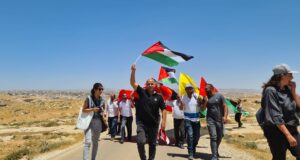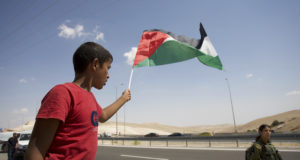June 19 – Once a year, the skies of Burin come alive with a dazzling display of color and resilience. The Kite Festival, organized by residents and activists, brings the community together in a joyful celebration of resistance and steadfast ...
Read More »Resisting Colonization in Beita
24 July 2024 | International Solidarity Movement | Beita Residents of Beita, south of Nablus, have restarted the weekly Friday demonstrations to resist the further theft of their land. In June, the Israeli security cabinet greenlighted the “legalization” of Evyatar, ...
Read More »Israeli Settlers in the West Bank Brutally Attack and Injure Palestinians and International Volunteers Only One Day After ICJ Rules Israeli Occupation Illegal
On the heels of the ICJ decision pronouncing Israeli occupation illegal as a whole and pointing out to systematic lack of accountability for settler violence, three international volunteers were evacuated to a hospital in Nablus after being attacked by settlers ...
Read More »16-year-old boy killed during Friday demonstration
Amjad Nashat Abu Alya, 16, was killed by Israelis on Friday 29 during a demonstration in the village of al-Mughayyer. Amjad died in a hospital in Ramallah after being shot in the chest. Eyewitnesses said he was running to safety ...
Read More »Join ISM: Training in Bristol & Belfast, July 24, 2022
ISM UK & ISM Ireland are offering pre-training sessions in Bristol and Belfast this month for prospective volunteers who are interested in joining the International Solidarity Movement on the ground in Palestine. Attending the training session will give you ...
Read More »ISM Call to Action: Save Masafer Yatta!
The International Solidarity Movement is calling all activists and supporters to take urgent action against Israel’s ethnic cleansing of the Masafer Yatta region in the occupied West Bank. What is Masafer Yatta?: Masafer Yatta is a rural region ...
Read More »“Ridiculous, spurious, and easily disproved” – Huwaida Arraf responds to recent right-wing attacks on the International Solidarity Movement
Once again right-wing media, politicians, and even supposed academics are attacking the International Solidarity Movement (ISM) with spurious allegations that are easily disproved. This time it comes in their ongoing effort to undermine Representative Ilhan Omar, the Congresswoman from the ...
Read More »Webinar: International Solidarity & Resisting Colonization
Join ISM Northern California on Saturday, December 19, 2020, for a webinar to learn about the current situation on the ground in Palestine, grassroots resistance, and the work of the International Solidarity Movement.
Read More »Resistance in a time of annexation and Covid-19 – an ISM webinar
ISM will be hosting a webinar on June 30th, Tuesday 20:00 Ramallah time, on annexation, COVID-19, resistance and international solidarity with the Palestinian struggle for equality and justice.
Read More »Keep Palestinian-led activism alive during COVID-19
ISM's human rights activism faces an unprecedented challenge in the current COVID-19 pandemic, international travel bans and global economic down turn. We ask for your support to help us maintain our ongoing projects and keep our offices ready to resume on the ground international solidarity and action for Palestine when the virus is contained.
Read More » International Solidarity Movement Nonviolence. Justice. Freedom.
International Solidarity Movement Nonviolence. Justice. Freedom.









